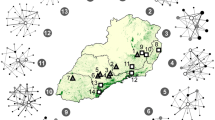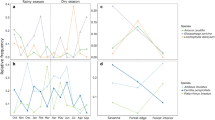Abstract
In networks of plant–animal mutualisms, different animal groups interact preferentially with different plants, thus forming distinct modules responsible for different parts of the service. However, what we currently know about seed dispersal networks is based only on birds. Therefore, we wished to fill this gap by studying bat–fruit networks and testing how they differ from bird–fruit networks. As dietary overlap of Neotropical bats and birds is low, they should form distinct mutualistic modules within local networks. Furthermore, since frugivory evolved only once among Neotropical bats, but several times independently among Neotropical birds, greater dietary overlap is expected among bats, and thus connectance and nestedness should be higher in bat–fruit networks. If bat–fruit networks have higher nestedness and connectance, they should be more robust to extinctions. We analyzed 1 mixed network of both bats and birds and 20 networks that consisted exclusively of either bats (11) or birds (9). As expected, the structure of the mixed network was both modular (M = 0.45) and nested (NODF = 0.31); one module contained only birds and two only bats. In 20 datasets with only one disperser group, bat–fruit networks (NODF = 0.53 ± 0.09, C = 0.30 ± 0.11) were more nested and had a higher connectance than bird–fruit networks (NODF = 0.42 ± 0.07, C = 0.22 ± 0.09). Unexpectedly, robustness to extinction of animal species was higher in bird–fruit networks (R = 0.60 ± 0.13) than in bat–fruit networks (R = 0.54 ± 0.09), and differences were explained mainly by species richness. These findings suggest that a modular structure also occurs in seed dispersal networks, similar to pollination networks. The higher nestedness and connectance observed in bat–fruit networks compared with bird–fruit networks may be explained by the monophyletic evolution of frugivory in Neotropical bats, among which the diets of specialists seem to have evolved from the pool of fruits consumed by generalists.



Similar content being viewed by others
References
Almeida-Neto M, Guimarães PR, Guimarães PR Jr, Loyola RD, Ulrich W (2008) A consistent metric for nestedness analysis in ecological systems: reconciling concept and measurement. Oikos 117:1227–1239
Bascompte J (2009) Disentangling the web of life. Science 325:416–419
Bascompte J, Jordano P (2007) Plant–animal mutualistic networks: the architecture of biodiversity. Annu Rev Ecol Evol Syst 38:567–593
Bascompte J, Jordano P, Melian CJ, Olesen JM (2003) The nested assembly of plant–animal mutualistic networks. Proc Natl Acad Sci USA 100:9383–9387
Bastolla U, Fortuna MA, Pascual-Garcia A, Ferrera A, Luque B, Bascompte J (2009) The architecture of mutualistic networks minimizes competition and increases biodiversity. Nature 458:U1018–U1091
Batagelj V, Mrvar A (1998) Pajek–a program for large network analysis. Connections 21:47–57
Bezerra ELS, Machado ICS, Mello MAR (2009) Pollination networks of oil-flowers: a tiny world within the smallest of all worlds. J Anim Ecol 78:1096–1101
Blondel J (2003) Guilds or functional groups: does it matter? Oikos 100:223–231
Blüthgen N, Menzel F, Blüthgen N (2006) Measuring specialization in species interaction networks. BMC Ecology 6:1–12
Blüthgen N, Menzel F, Hovestadt T, Fiala B, Bluthgen N (2007) Specialization, constraints, and conflicting interests in mutualistic networks. Curr Biol 17:341–346
Blüthgen N, Frund J, Vazquez DP, Menzel F (2008) What do interaction network metrics tell us about specialization and biological traits? Ecology 89:3387–3399
Boucher DH, James S, Keeler KH (1982) The ecology of mutualism. Annu Rev Ecol Syst 13:315–347
Burgos E, Ceva H, Perazzo RPJ, Devoto M, Medan D, Zimmermann M, MarÌa Delbue A (2007) Why nestedness in mutualistic networks? J Theor Biol 249:307–313
Cazetta E, Schaefer H, Galetti M (2009) Why are fruits colorful? The relative importance of achromatic and chromatic contrasts for detection by birds. Evol Ecol 23:233–244
Cipollini ML, Levey DJ (1997) Why are some fruits toxic? Glykoalkaloids in Solanum and fruit choice by vertebrates. Ecology 78:782–798
Datzmann T, von Helversen O, Mayer F (2010) Evolution of nectarivory in phyllostomid bats (phyllostomidae gray, 1825, chiroptera: mammalia). BMC Evol Biol 10:165
Dormann CF, Gruber B, Fründ J (2008) Introducing the bipartite package: analyzing ecological networks. R News 8:8–11
Dormann CF, Fründ J, Blüthgen N, Gruber B (2009) Indices, graphs and null models: analyzing bipartite ecological networks. Open Ecol J 2:7–24
Fleming TH, Sosa VJ (1994) Effects of nectarivorous and frugivorous mammals on reproductive success of plants. J Mammal 75:845–851
Fleming TH, Breitwisch R, Whitesides GH (1987) Patterns of tropical vertebrate frugivore diversity. Annu Rev Ecol Syst 18:91–109
Fonseca CR, Ganade G (1996) Asymmetries, compartments and null interactions in an Amazonian ant–plant community. J Anim Ecol 66:339–347
Fortuna MA, Stouffer DB, Olesen JM, Jordano P, Mouillot D, Krasnov BR, Poulin R, Bascompte J (2010) Nestedness versus modularity in ecological networks: two sides of the same coin? J Anim Ecol 79:811–817
Galindo-Gonzáles J, Guevara S, Sosa VJ (2000) Bat and bird-generated seed rains at isolated trees in pastures in a tropical rainforest. Conserv Biol 14:1693–1703
Guimaraes PR, Rico-Gray V, Oliveira PS, Izzo TJ, dos Reis SF, Thompson JN (2007) Interaction intimacy affects structure and coevolutionary dynamics in mutualistic networks. Curr Biol 17:1797–1803
Guimarães PR, Machado G, de Aguiar MAM, Jordano P, Bascompte J, Pinheiro A, dos Reis SF (2007) Build-up mechanisms determining the topology of mutualistic networks. J Theor Biol 249:181–189
Guimerà R, Amaral LAN (2005) Cartography of complex networks: modules and universal roles. J Stat Mech Theory Exp P02001
Howe HF, Smallwood J (1982) Ecology of seed dispersal. Annu Rev Ecol Syst 13:201–228
Jordano P (1987) Patterns of mutualistic interactions in pollination and seed dispersal—connectance, dependence asymmetries, and coevolution. Am Nat 129:657–677
Jordano P, Bascompte J, Olesen JM (2003) Invariant properties in coevolutionary networks of plant–animal interactions. Ecol Lett 6:69–81
Jordano P, Vázquez D, Bascompte J (2009) Redes complejas de interacciones mutualistas planta–animal. In: Medel R, Aizen M, Zamora R (eds) Ecología y evolución de interacciones planta–animal. Editorial Universitaria, Santiago, pp 17–41
Kalko EKV, Ayasse M (2009) Study and analysis of odor involved in behavioral ecology of bats. In: Kunz TH, Parsons S (eds) Ecological and behavioral methods for the study of bats, 2nd edn. The Johns Hopkins University Press, Baltimore, pp 491–499
Kissling WD, Gaese KB, Jetz W (2009) The global distribution of frugivory in birds. Glob Ecol Biogeogr 18:150–162
Korine C, Kalko EKV, Herre EA (2000) Fruit removal by bats and birds from a community of strangler figs in Panama. Oecologia 123:560–568
Levey DJ, Silva WR, Galetti M (2002) Seed dispersal and frugivory : ecology, evolution, and conservation. CABI Publishing, New York
Lobova TA, Geiselman CK, Mori SA (2009) Seed dispersal by bats in the Neotropics. New York Botanical Garden Press, New York
Melo FPL, Rodriguez-Herrera B, Chazdon RL, Medellin RA, Ceballos GG (2009) Small tent-roosting bats promote dispersal of large-seeded plants in a Neotropical forest. Biotropica 41:737–743
Mills LS, Soule ME, Doak DF (1993) The keystone-species concept in ecology and conservation. Bioscience 43:219–224
Muscarella R, Fleming TH (2007) The role of frugivorous bats in tropical forest succession. Biol Rev 82:573–590
Nogueira MR, Peracchi AL (2003) Fig-seed predation by 2 species of Chiroderma: discovery of a new feeding strategy in bats. J Mammal 84:225–233
Nooy W, Mrvar A, Batagelj V (2005) Exploratory social network analysis with Pajek. Cambridge University Press, New York
Olesen JM, Bascompte J, Dupont YL, Jordano P (2006) The smallest of all worlds: pollination networks. J Theor Biol 240:270–276
Olesen JM, Bascompte J, Dupont YL, Jordano P (2007) The modularity of pollination networks. Proc Natl Acad Sci USA 104:19891–19896
Oliver TH, Leather SR, Cook JM (2008) Macroevolutionary patterns in the origin of mutualisms involving ants. J Evol Biol 21:1597–1608
Root RB (1967) The niche exploitation pattern of the blue-gray gnatcatcher. Ecol Monogr 37:317–350
Scheffer M, Bascompte J, Brock WA, Brovkin V, Carpenter SR, Dakos V, Held H, van Nes EH, Rietkerk M, Sugihara G (2009) Early-warning signals for critical transitions. Nature 461:53–59
Terborgh J, Pitman N, Silman M, Schichter H, Núñes VP (2002) Maintenance of tree diversity in tropical forests. In: Levey DJ, Silva WR, Galetti M (eds) Seed dispersal and frugivory : ecology, evolution, and conservation. CABI Publishing, New York, pp 1–17
Thies W, Kalko EKV (2004) Phenology of Neotropical pepper plants (Piperaceae) and their association with their main dispersers, two short-tailed fruit bats, Carollia perspicillata and C. castanea (Phyllostomidae). Oikos 104:362–376
van der Pijl L (1972) Principles of dispersal in higher plants. Springer, Berlin
Walker BH (1992) Biodiversity and ecological redundancy. Conserv Biol 6:18–23
Watts DJ, Strogatz SH (1998) Collective dynamics of small-world networks. Nature 393:440–442
Wendeln MC, Runkle JR, Kalko EKV (2000) Nutritional values of 14 fig species and bat feeding preferences in Panama. Biotropica 32:489–501
Wilmers CC, Sinha S, Brede M (2002) Examining the effects of species richness on community stability: an assembly model approach. Oikos 99:363–367
Wright SJ (2002) Plant diversity in tropical forests: a review of mechanisms of species coexistence. Oecologia 130:1–14
Acknowledgments
We are especially grateful to all people who made their data available in papers, monographs or databases. Carsten Dormann, Mário Almeida-Neto, Nico Blüthgen, Roger Guimerà and Vladimir Batagelj helped us use their network software. Theodore Fleming made invaluable suggestions on an early version of this manuscript. Diego Vazquez created the Interaction Web Database (http://www.nceas.ucsb.edu/interactionweb/), from which we took some datasets. Many colleagues, especially Wibke Thies, helped to complement the ‘Kalko BCI dataset’ after its first publication in 2004. Fundação de Amparo à Pesquisa do Estado de São Paulo (Brazil) funded this project by giving Grants to M.A.R.M. (2006/00265-0), F.M.D.M., M.A.M.A. and P.R.G. M.A.R.M. was also supported by the Alexander von Humboldt Foundation (Germany, 1134644). E.K.V.K. was supported by the Deutsche Forschungsgemeinschaft (Germany), and P.J. by the Consejo Superior de Investigaciones Cientificas (Spain). Experiments comply with the current laws of Germany, Brazil and Spain.
Author information
Authors and Affiliations
Corresponding author
Additional information
Communicated by Steven Johnson.
Electronic supplementary material
Below is the link to the electronic supplementary material.
Rights and permissions
About this article
Cite this article
Mello, M.A.R., Marquitti, F.M.D., Guimarães, P.R. et al. The modularity of seed dispersal: differences in structure and robustness between bat– and bird–fruit networks. Oecologia 167, 131–140 (2011). https://doi.org/10.1007/s00442-011-1984-2
Received:
Accepted:
Published:
Issue Date:
DOI: https://doi.org/10.1007/s00442-011-1984-2




